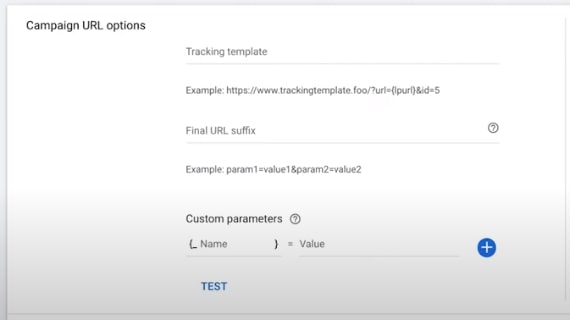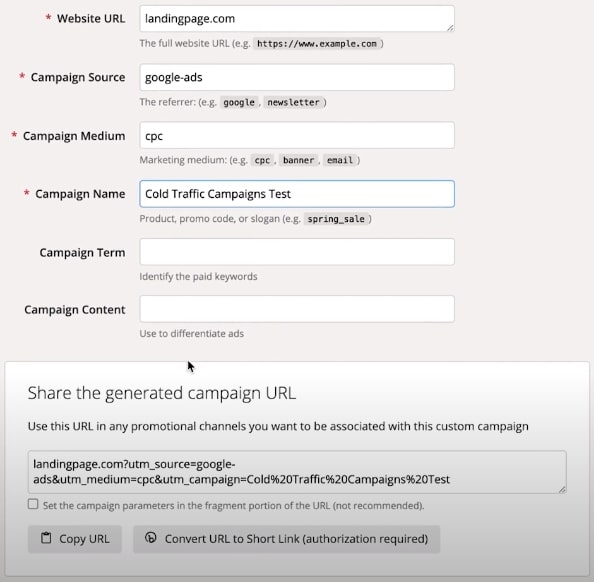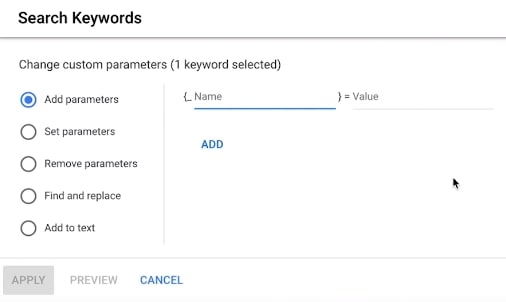UTM tracking in Google Ads is just one of the things you’ll have to learn to use when you start off. It’s very simple to set up and is a useful way of seeing where exactly your traffic is coming from. There’s a lot more to it so, in this blog post, we’ll be explaining in more depth why this type of tracking is useful and how to use it properly.
What are UTMs?
UTM (Urchin Tracking Module) originated with Urchin Software Corporation, a company bought by Google in 2005. Google turned this acquisition into Google Analytics.
At KonvertLab we actually require all of our team members to use UTMs in every campaign before turning them on. The big reasons for this are that it saves us a lot of headaches down the line but also because it enables us to see a lot more parameters in any third-party dashboards we use. In turn, we can see where our biggest leads are coming from. Here’s what a basic UTM tracking template looks like:
Most of this is self-explanatory but before we continue, let’s break down what some of this actually means.
- lpurl stands for landing page URL. When someone clicks on your ad, this parameter is changed to the URL of the specific landing page the ad is taking them too.
- The device parameter does the same thing. After clicking on the ad, the device parameter is switched to mobile or desktop.
- _campaignname is replaced by the name of the campaign which the ad they clicked on belongs to. This is actually a custom parameter, and we’ll be explaining those later in this blog post.
The rest of this is pretty straightforward, but it should be clear how tracking this kind of information can be useful.
Why is Google Ads UTM Tracking Important?
If you’re wondering why this is so important if all you want to do is run a Google Ads campaign, you’re not alone. Unfortunately, a lot of people miss out on the benefits of UTM tracking by either not using them at all or setting them up incorrectly.
UTM tracking helps you to identify which leads and sales came from which sources so that you can optimize your strategy further around this information. This is especially useful if you’re using third-party tools like Salesforce or Marketo. It’s even useful if you’re just looking at your data through analytics.
How to Set Up UTM Tracking
There’s nothing complex about this but for beginners, anything new in Google Ads can be daunting. To ensure you make no mistakes and help you along the way, here’s how to set up UTM tracking.

Start off by going into your Google Ads account and going to your Campaigns menu. Click on any of your campaigns or if you don’t have any ready, go ahead and create a new one now.
Once you’re in the campaign, click Settings on the sidebar menu then on the page you’re taken to, locate Campaign URL options. Click on this setting and here’s what you’ll see:

This is what the options will look like before populating it with our UTM tracking template. Before we continue, you should familiarize yourself with the available ValueTrack parameters. These are the ones which Google will auto-populate for you.
Back to the Campaign URL Options, now paste the template that we showed you above. If there are other parameters you want to track that are listed on the ValueTrack parameters page, add them to the template too.
To confirm that your UTM tracking code works, click Test. This will present you with an example of what it will look like once live. Doing this only takes a few seconds and if there are any typos or missing brackets, testing the code will highlight them.
Custom Parameters
Custom parameters allow you to track more data than the generic parameters allow. So, let’s say we want to track the campaign name (by default, Google only provides the campaign ID parameter). We’d set the parameter to _campaignname and the value to whatever the name of your campaign is. One important detail is that for the value, there can’t be any spaces. If your campaign is called UTM Test, the value could be UTMTest or UTM_Test. You can, however, also put UTM%20Test which will result in a space anyway.
The downside of this particular custom parameter is that it has to be set on a campaign level, and you must manually set it. This doesn’t take away from the usefulness of having that data available though.

To add this parameter to your tracking code, you’d add &campaign-name=(_campaignname) – that’s it. Now, when you press the Test button, you’ll see that our custom parameter has been edited and the value for _campaignname has been switched out.
Google Ads Campaign URL Builder
If all of the above seems like a bit too much for you to take on, Google’s Campaign URL Builder can help. Basically, this will make it easier for you to create your UTM tracking code and you don’t have to worry about formating spaces correctly either.

As you can see, we’ve set the campaign name as Cold Traffic Campaigns Test. This tool then automatically formats it in the URL as Cold%20Traffic%20Campaigns%20Test.
When you use this tool, we recommend copying the URL from the question mark onwards and just using that section. If you go back to the Campaign URL options, you can replace the tracking code from the question mark onwards with your new code.
2 things to always remember. First, always have an ampersand (&) after every parameter and second, always test your URL after making changes.
Setting Custom Parameters on the Keyword Level
This isn’t something we do frequently but if you want to get really fancy, you can add custom parameters to specific keywords.

Just head over to your keywords, select a keyword, click Edit, and select Change custom parameters.

From here you can add custom parameters the same as before and this can be beneficial in different ways.
Wrapping Up UTM Tracking
Hopefully now you feel more confident about UTM tracking, how to set it up on your own campaigns, and know how it can help you advance your marketing efforts. As scary as it seems, setting this up is extremely straightforward and is undoubtedly worthwhile.
That being said, taking full advantage of UTM tracking without experience can be stressful. This is where KonvertLab can be of help. Our years of experience as a Google Ads agency puts its in the perfect position to help your business manage your campaigns, from properly tracking their performance to split testing various ads. Book a call below and let’s discuss why we should work together!
